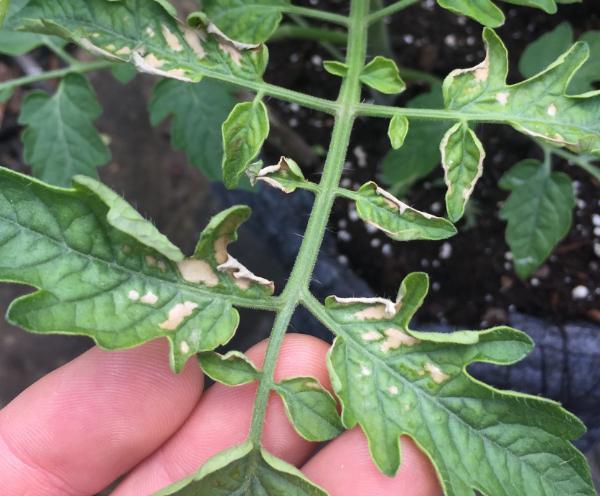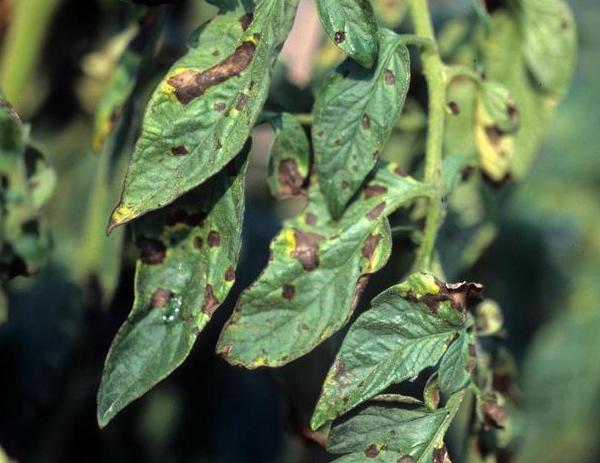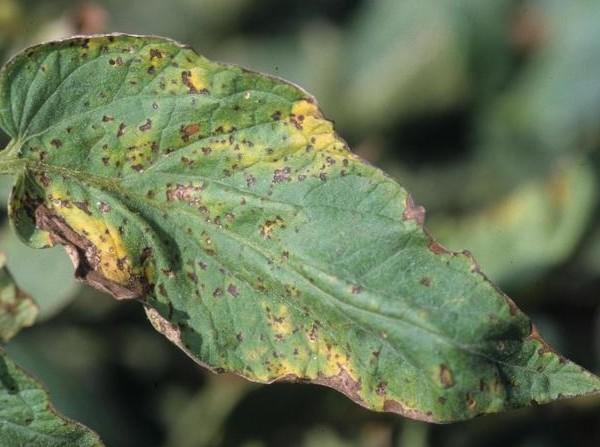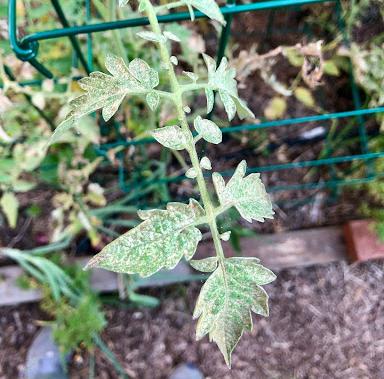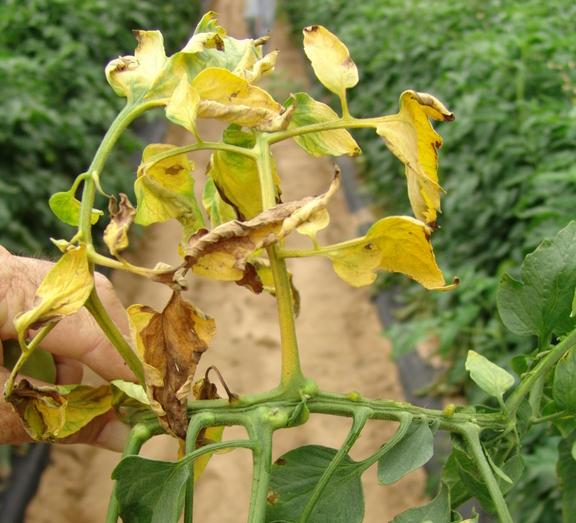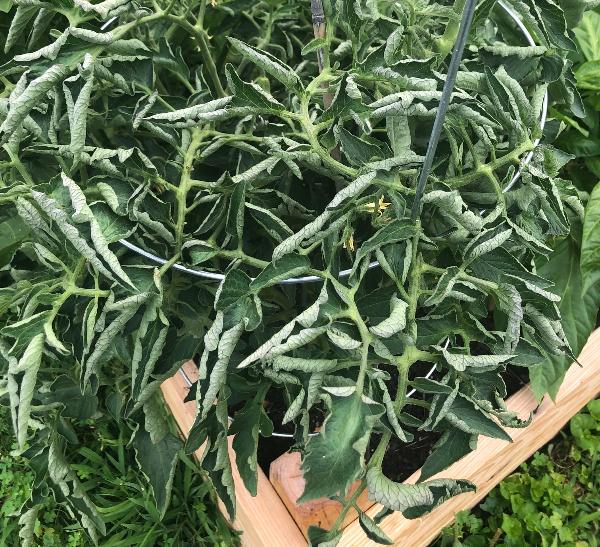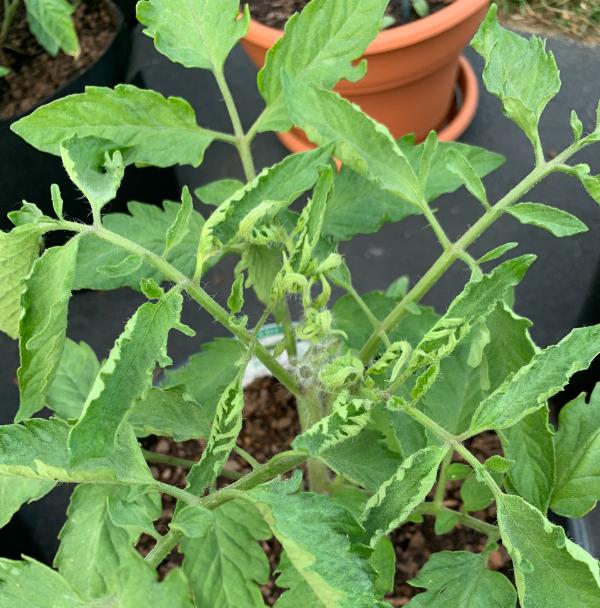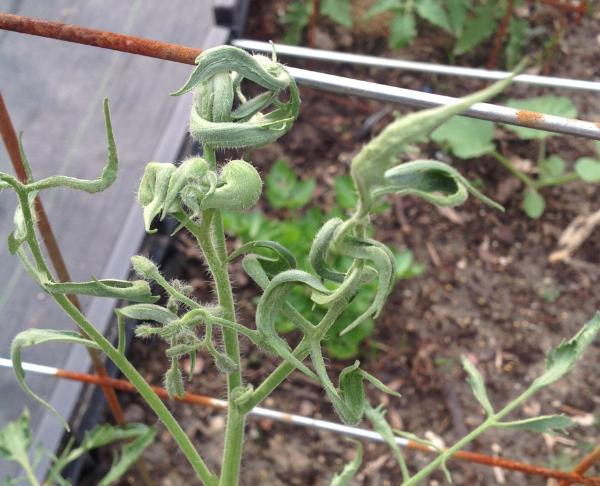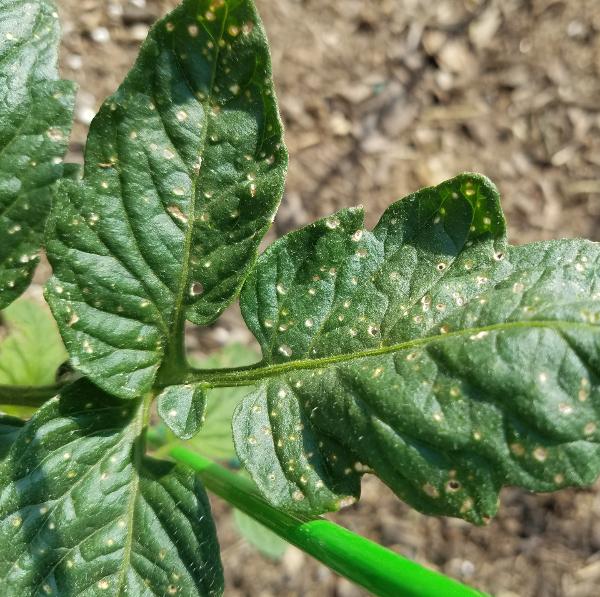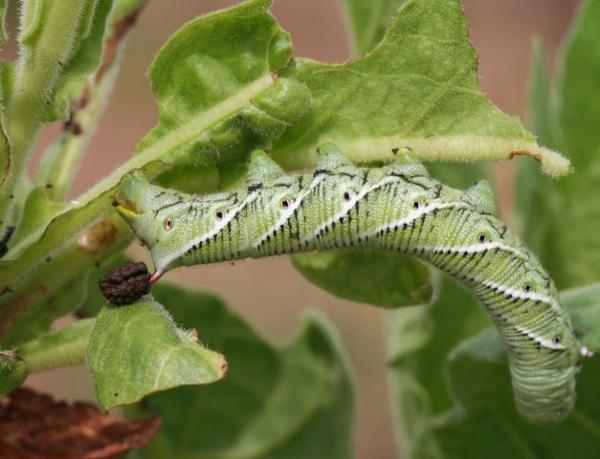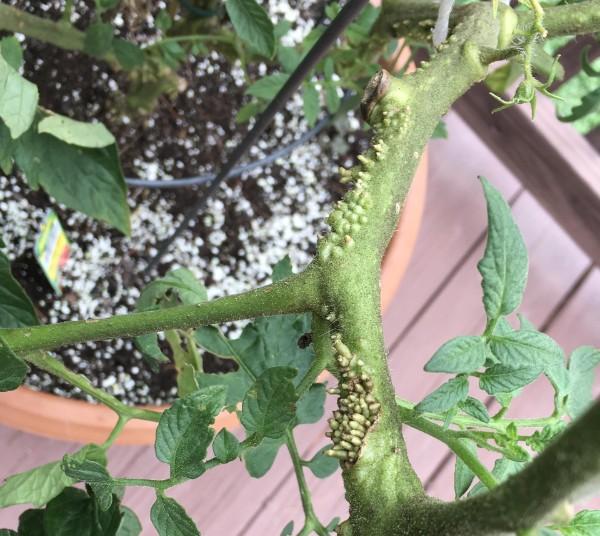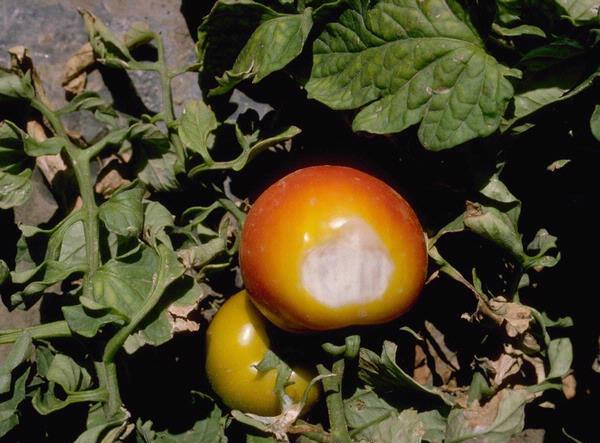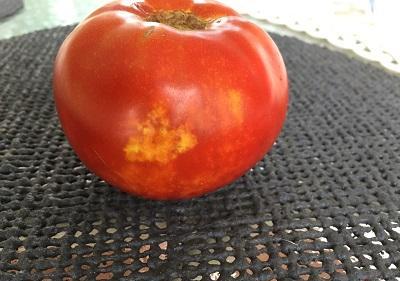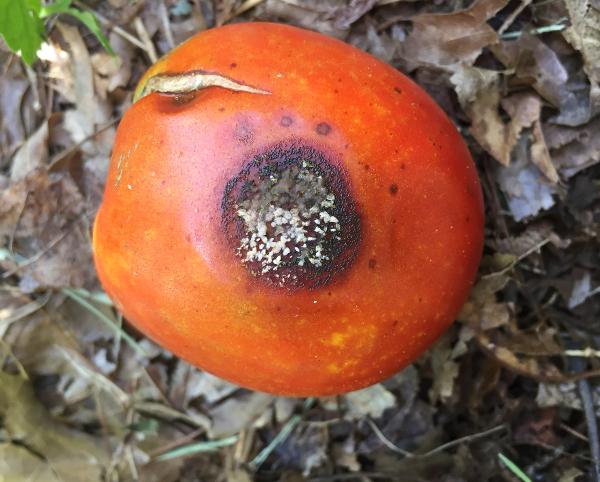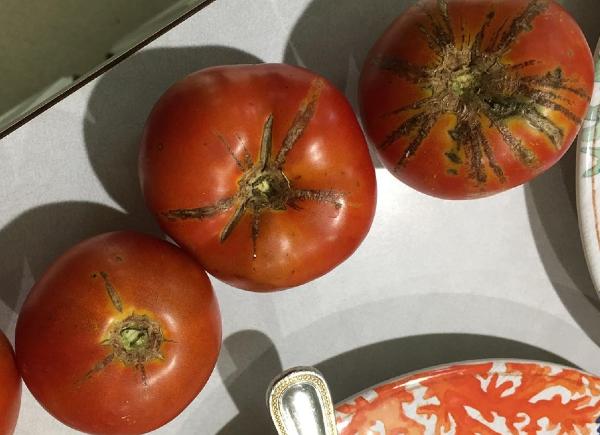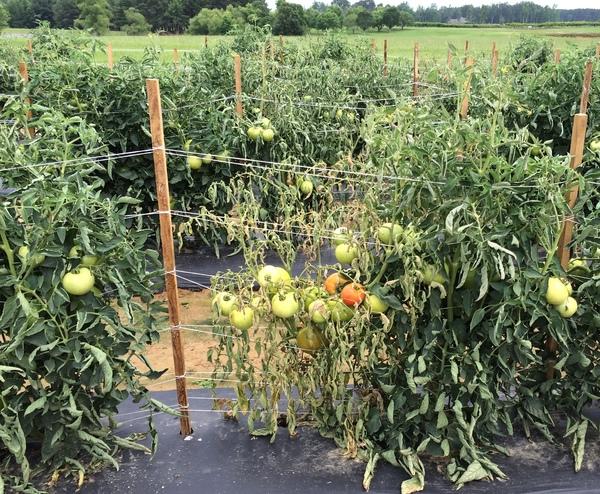| Leaf Spots |
Small, brown lesions with yellow halos that rapidly enlarge; “bull’s-eye” pattern within lesions. Lower leaves affected first |
Early blight
|
Very common |
| |
Small, round tan/gray spots with dark margins on lower leaves |
Septoria leaf spot |
Very common |
| |
Tiny, dark brown circular spots that develop yellow rings (halos) |
Bacterial diseases |
Occasional |
| |
Dark, raised spots on upper surfaces caused by excessive moisture |
Edema |
Occasional |
| Leaf/stem blotches and blights |
Advanced symptoms of various fungal and bacterial diseases |
See above |
Occasional |
| |
Dark brown blotches on leaf tips and margins that enlarge rapidly, producing a water-soaked appearance |
Late blight |
Not common; requires cool, wet weather |
| |
Brown-black cankers on the lower stem, followed by plant wilting |
Southern blight |
Occasional |
| Leaf Yellowing |
Lower leaves yellowing and stems wilting, internal stem tissue discolored |
Fusarium wilt
Verticillium wilt
|
Fusarium wilt is more common than Verticillium |
| |
Tiny yellow spots (stippling); leaves may appear dirty on the undersides |
Spider mites |
Common in hot dry weather |
| |
Interveinal yellowing: potassium, iron, magnesium, or manganese.
Older leaves first, then newer leaves: nitrogen |
Nutrient deficiency |
Occasional |
| Purple leaves |
Primarily on transplants (leaf undersides) |
Phosphorous deficiency |
Common |
| Leaf curling/distortion |
Small, soft, pink or green insects on young growth |
Aphids |
Common |
| |
Lower leaves curl upward first |
Water stress |
Common |
| |
Lower leaf curling upward during hot weather |
Varietal characteristics or heat stress |
Common |
| |
Damage on new growth. Leaves become narrow, twisted, crinkled, curled, or finely divided |
Herbicide damage (2,4-D, glyphosate, dicamba, and others) |
Occasional |
| |
Mottled, deformed leaves; stunted plants |
Mosaic viruses |
Occasional |
| Leaf and stem browning |
Leaves brown and die; lesions extend to stems |
Early blight |
Very common |
| |
Wilting precedes browning |
Fusarium wilt |
Occasional |
| Stems/entire plant wilts |
Wilting of lower branches first; plants recover at night; discolored stem tissue |
Fusarium wilt |
Occasional |
| |
Similar to fusarium |
Verticillium wilt |
Uncommon |
| |
Dark canker forms at the soil line followed by plant collapse |
Southern blight |
Occasional |
| |
Newer growth wilts |
Drought stress |
Occasional |
| |
Roots deprived of oxygen |
Standing water |
Occasional |
| |
Wilting/stunting of plants next to a walnut tree |
Walnut wilt |
Uncommon |
| Leaves with holes |
Tiny holes in the shothole pattern. Small, shiny dark insects that jump when disturbed |
Flea beetle |
Occasional |
| Leaves chewed |
Mid to late summer pest; very large with red or black “horn”; strip foliage off branches |
Hornworms |
Common |
| |
Gray or black caterpillars; feed on young or mature plants at night |
Cutworms |
Occasional |
| Nubby growths on stems |
Varietal characteristic; aerial roots |
Adventitious roots |
Occasional |
| Failure to flower or fruit |
Unusually tall, lush plants |
Excessive nitrogen or limited sunlight |
Occasional |
| |
Poor pollination/aborted fruits with temperature extremes |
High or low temperatures |
Occasional |
| Large holes chewed in fruit |
Chew or scrape green fruit |
Hornworms |
Common |
| |
Climb onto mature plants to feed on fruit |
Cutworms and armyworms |
Occasional |
| |
Bore deeply into young, green fruit; fruits ripen prematurely; secondary rots often develop |
Tomato fruit worm |
Occasional |
| |
Pecked, torn, or chewed fruits; often one “strike” per fruit; more noticeable during drought |
Animals (birds, squirrels, groundhogs, deer) |
Common |
| Spots on fruit |
Tiny spots or flecks on fruits |
Bacterial speck |
Occasional |
| |
Small raised brown spots; larger than bacterial speck lesions |
Bacterial spot |
Occasional |
| |
Yellow or white spots or blotches beneath fruit skin |
Stink bug |
Common |
| |
Dark, leathery lesions may be shrunken; a “bull’s eye” pattern may be visible; usually at the stem end |
Early blight |
Very common |
| |
Soft rot; circular, brown/black, shrunken lesions on ripening fruit. Produces salmon-color spore mass |
Anthracnose |
Very common |
| |
Olive-green to black, oily-looking lesions; wet rots develop under favorable conditions |
Late blight |
Not common |
| Large discolored areas on fruit |
Dark, leathery lesions on the fruit bottom. Most prevalent on enlarging fruit |
Blossom-end rot |
Very common |
| |
Light colored; becomes soft. Typically on surfaces exposed to full sunlight due to defoliation |
Sunscald |
Common |
| |
Varietal characteristic; often affects large-fruited varieties |
Green shoulder |
Occasional |
| Internal discoloration |
Excessive white tissue inside fruits |
Low potassium levels in fruits; environmental stress
Internal discoloration
Tomato ripening problems
|
Occasional |
| Failure to ripen/slow ripening |
|
Low sunlight, plant crowding, excessive nitrogen, insufficient ripening time, high temperatures |
Occasional |
| Uneven ripening |
Especially on large-fruited and plum-type varieties, late in the growing season |
Varietal characteristics, cold temperatures, or reduced light |
Common |
| Distortion/malformed fruit |
Damage most common on the first cluster of fruits |
Cool temperatures below 50 degrees Fahrenheit, Catfacing
|
Common |
| Cracking |
Concentric and radial cracks on ripe fruit. Also small horizontal cracks (rain checking) |
Excessive moisture, excessive nitrogen fertilization after fruits form; Cracking |
Common |

